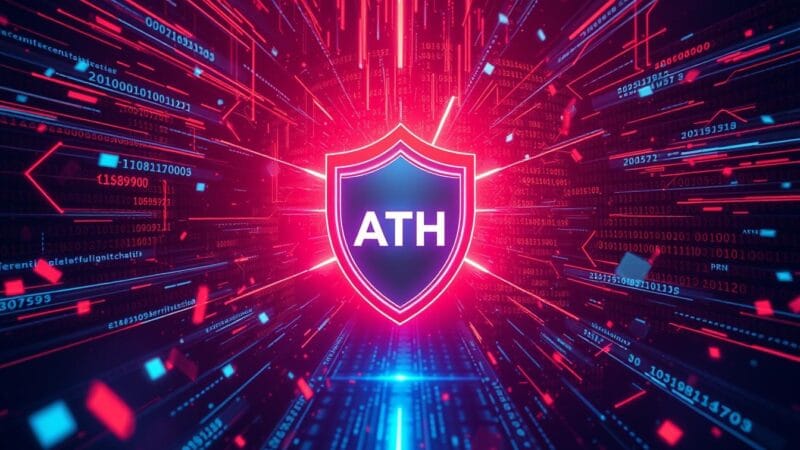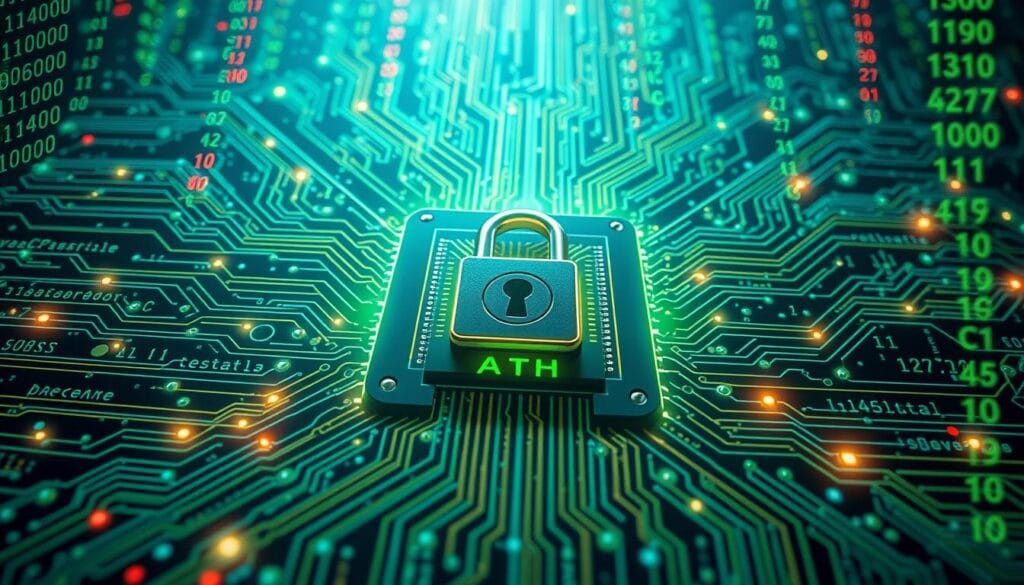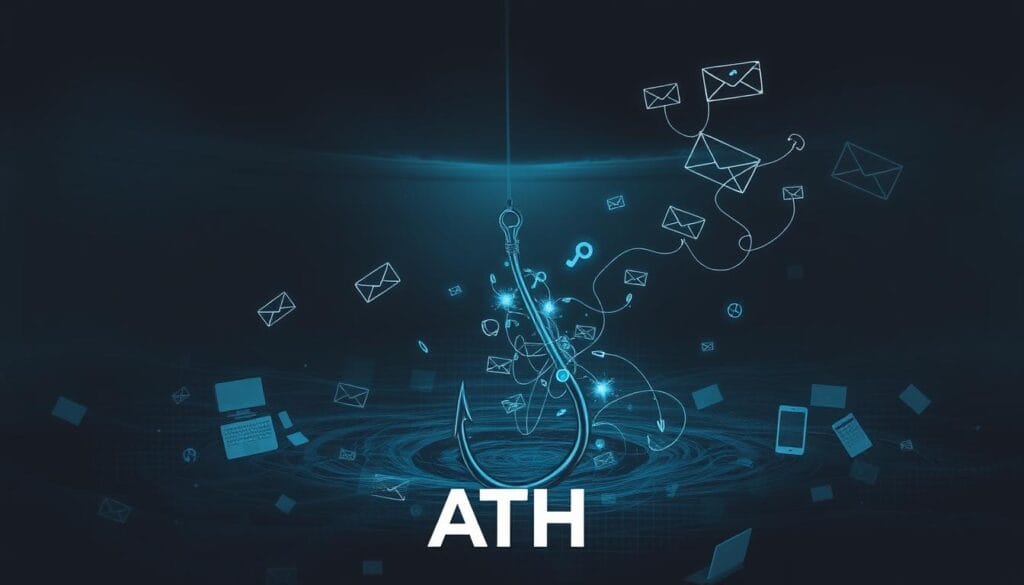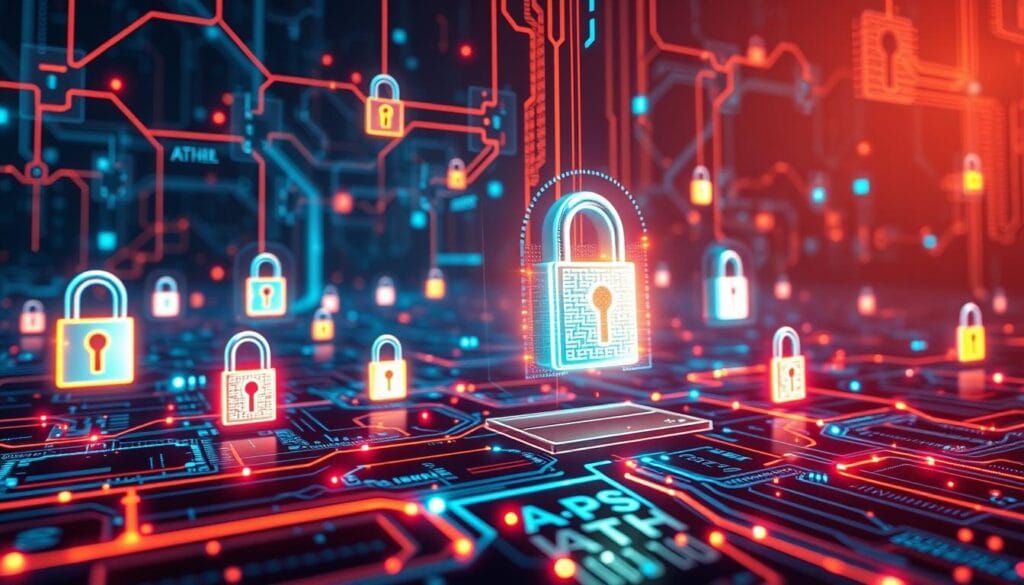Cybersecurity Awareness: Protect Your Digital Life in 2025

Did you know cybercrime costs the world over $6 trillion a year? In today’s digital world, keeping your online life safe is key. This guide will teach you how to protect yourself from cyber threats.
Cybersecurity is now a must, not a luxury. With technology in our daily lives, from banking to socializing, risks have grown. Learning about cybersecurity and using safe practices can keep your info safe.
Key Takeaways
- Cybersecurity awareness is essential in today’s digital world to protect your personal and professional online activities.
- Cyber threats, such as data breaches and identity theft, have escalated due to our increased reliance on technology.
- Understanding the importance of cybersecurity and mastering proven techniques can help you take control of your digital safety and privacy.
- This comprehensive guide will provide you with the knowledge and strategies to safeguard your sensitive information and online activities.
- By investing in cybersecurity awareness, you can proactively defend against a wide range of cyber threats and enjoy a more secure digital life.
Understanding the Importance of Cybersecurity Awareness
In today’s world, cybersecurity awareness is key. We use digital platforms for work, talking, and fun. It’s vital to protect ourselves from cyber threats. Learn why cybersecurity is important and the dangers of cyber attacks and data breaches.
Why Cybersecurity Matters in Today’s Digital World
Technology has changed how we live and work. We use online banking, social media, and cloud storage. Our lives are now linked to the digital world. This makes us more at risk for online risks like identity theft and data loss.
The Consequences of Cyber Threats and Attacks
Cyber threats and attacks can harm a lot. Data breaches can steal personal and financial info. This can lead to identity theft and financial fraud. Malware and ransomware can also hurt businesses, causing money and reputation loss.
- Loss of personal and financial data
- Identity theft and financial fraud
- Disruption of business operations
- Reputational damage for organizations
It’s crucial to understand cybersecurity awareness. We must protect ourselves and our digital stuff in today’s tech world.

Phishing Attacks: Recognizing and Avoiding Scams
Phishing attacks are a big problem today. They are sneaky ways for bad guys to get your private info. It’s key to know how to spot and dodge these scams to keep your online world safe.
Phishing scams look like real emails or websites. They try to trick people into sharing their personal info. Cybersecurity best practices tell us to always be careful and question any email scams or weird online stuff.
Recognizing Phishing Attempts
To stay safe from phishing attacks, you need to know the signs. Watch for these:
- Scary or urgent messages that try to scare you
- Requests for your personal or money info, pretending to be real
- Strange email addresses or website names
- Messages that sound fake or are too general
Avoiding Phishing Scams
If you think you’ve seen a phishing attack, don’t panic. Here’s what to do:
- Check if the email is real by calling the company
- Don’t click on links or open attachments from unknown places
- Be careful when giving out personal info on new websites
- Turn on two-factor authentication to make your accounts safer
- Keep up with the latest cybersecurity best practices and social engineering tricks
Knowing about phishing attacks and using good online fraud prevention can help a lot. This way, you can protect your digital life from these sneaky scams.

Malware Protection: Safeguarding Your Devices
Malware, like viruses and ransomware, is a big threat to your devices and data. Knowing about different types of malware is key. It helps you use strong malware protection to keep your digital world safe.
Types of Malware and Their Dangers
There are many kinds of malware, each with its own dangers. Viruses can harm your system and spread. Trojans look like safe software but are not. They can get into your device without you knowing.
Ransomware locks your data until you pay a ransom. This can lead to losing important information.
Best Practices for Malware Prevention
- Use good antivirus software and update it often to catch and remove malware.
- Back up your data regularly. This way, you won’t lose it if malware attacks.
- Be careful with files and links from unknown sources. They can carry malware.
- Turn on automatic updates for your system and software. This keeps you safe from new threats.
- Think about using a device security tool like a firewall or VPN. It can help protect your devices from malware and other dangers.
By being careful and following these malware protection tips, you can lower the chance of your devices getting hacked. And you’ll keep your data safe from wrong hands.

| Type of Malware | Description | Potential Consequences |
|---|---|---|
| Viruses | Malicious software that can replicate and spread to other systems | System crashes, data corruption, and the potential for further malware infections |
| Trojans | Malware that disguises itself as legitimate software to gain unauthorized access | Theft of sensitive information, remote control of the infected device, and the introduction of additional malware |
| Ransomware | Malware that encrypts files and demands a ransom payment for their release | Permanent loss of data, financial extortion, and the potential for further system compromise |
Data Privacy: Protecting Your Personal Information
In today’s digital world, keeping your personal info safe is key. Data privacy is all about keeping your sensitive data safe from hackers. Knowing the risks of data breaches and identity theft helps you protect your info better.
Risks of Data Breaches and Identity Theft
Data breaches can leak your personal info, like your name and social security number. This info can be used for bad things, like identity theft. This can cause financial loss and harm to your credit. It’s important to protect your data to avoid these problems.
- Data breaches can expose your personal information, including your name, address, and financial details.
- Identity theft can result in financial losses, damaged credit, and legal issues.
- Cybersecurity best practices, such as using strong passwords and enabling two-factor authentication, can help mitigate the risks of data breaches and identity theft.
Understanding data privacy and using good cybersecurity practices helps protect your info. This way, you can avoid the dangers of data breaches and identity theft. Being proactive with your online safety is vital in today’s digital world.

Network Security: Securing Your Home and Work Networks
In today’s digital world, keeping your home and work networks safe is key. This protects your devices and personal info from cyber threats. Knowing how to secure your network is vital for a strong defense against cyber attacks.
Wireless Network Best Practices
For your wireless network, follow these tips to boost network security:
- Use strong encryption like WPA2 or WPA3 to keep your network safe from hackers.
- Change your network name (SSID) and password to something unique and hard to guess.
- Update your wireless router’s firmware often to get the latest security fixes.
- Think about hiding your network’s SSID to make it harder for attackers to find.
Firewall Configuration and Router Security
Setting up your firewall and router security right is key for your home and work networks. Here’s how to make your network more secure:
- Turn on your router’s firewall and make sure it blocks unwanted access.
- Change your router’s admin login to something strong and unique.
- Keep your router’s firmware up to date to fix security holes.
- Think about adding a dedicated firewall device for extra security.
| Network Security Best Practices | Description |
|---|---|
| Wireless Network Encryption | Use strong encryption like WPA2 or WPA3 to protect your wireless network. |
| Router Firmware Updates | Update your router’s firmware often to get the latest security patches. |
| Firewall Configuration | Turn on and set up your router’s firewall to block unwanted access. |
| Router Password Security | Change your router’s admin login to a strong, unique password. |

By following these wireless network safety and router security tips, you can make your home and work networks much safer. This protects your devices and personal info from cyber threats.
Password Hygiene: Creating and Managing Strong Passwords
In today’s world, strong passwords are key to keeping your online life safe. Good password management is a must for everyone online. By making and keeping strong, unique passwords, you lower the chance of hackers getting into your stuff.
Crafting Powerful Passwords
For strong passwords, length and complexity matter a lot. Don’t use common words or personal info that’s easy to guess. Make passwords that mix letters, numbers, and symbols. The longer, the better, with 12 characters as a minimum.
- Use a passphrase: A passphrase is a sequence of words that is easy for you to remember but difficult for others to guess.
- Incorporate random elements: Include a random mix of characters, such as a memorable phrase with numbers and symbols.
- Avoid common patterns: Steer clear of easily identifiable patterns, such as “123456” or “abcdef”.
Securely Managing Your Passwords
After making strong passwords, it’s important to store and manage them well. Don’t use the same password for all accounts, as it’s risky. Use a password manager to keep your login details safe and organized.
- Utilize a password manager: Password managers generate, store, and automatically fill in your passwords, enhancing both security and convenience.
- Enable two-factor authentication: Add an extra layer of protection to your accounts by enabling two-factor authentication, which requires a secondary verification step beyond just your password.
- Regularly update your passwords: Make it a habit to periodically update your passwords, especially for your most sensitive accounts.
By focusing on password hygiene and following these tips, you can protect your digital world. This helps prevent password security and password management issues.
Cybersecurity Awareness: Protect Your Digital Life
In today’s world, cybersecurity threats are everywhere. It’s important to be proactive and take steps to protect your online life. Cybersecurity awareness helps you stay safe and confident online.
Understanding cybersecurity is the first step to protecting yourself. Knowing about new threats helps you avoid dangers. Cybersecurity awareness is essential in today’s digital world.
This guide has shown you how to stay safe online. We’ve talked about spotting scams, keeping devices safe, and protecting your data. These steps help you control your digital security and keep your information safe.
Being aware of cybersecurity lets you feel safe online. It helps you avoid cyber threats and attacks. Remember, staying informed and proactive is key to keeping your digital life safe.
| Cybersecurity Practice | Description | Benefits |
|---|---|---|
| Phishing Awareness | Recognizing and avoiding fraudulent emails, messages, or websites that attempt to steal your personal information. | Protects you from identity theft and financial loss. |
| Malware Protection | Implementing measures to safeguard your devices against various types of malicious software, such as viruses, spyware, and ransomware. | Preserves the integrity and functionality of your devices, preventing data loss and unauthorized access. |
| Data Privacy | Protecting your personal information, including sensitive data, from unauthorized access or misuse. | Safeguards your identity, financial information, and digital footprint from the risks of data breaches and identity theft. |
| Network Security | Securing your home and work networks to prevent unauthorized access and ensure the confidentiality of your online activities. | Shields your digital communication and prevents the exploitation of your network vulnerabilities. |
| Password Hygiene | Creating and managing strong, unique passwords for your online accounts to prevent unauthorized access. | Enhances the security of your digital accounts, reducing the risk of password-related breaches. |
By following these best practices, you can protect your digital life. Remember, cybersecurity awareness is a continuous journey. Stay vigilant to keep your personal digital security safe.
Social Engineering: Identifying and Avoiding Manipulation Tactics
In today’s world, cybercriminals use smart tricks to get to your private info or systems. They use social engineering to play on people’s weaknesses. Knowing these tricks and staying alert is key to keeping your online world safe.
Common Social Engineering Techniques
These tactics play on your feelings and thoughts to get you to share secrets or do things that aren’t safe. Here are some common ones:
- Phishing: Fake emails or messages that look real, trying to get you to share login details or click bad links.
- Pretexting: Making up a story to get you to share important info or let them into your systems.
- Baiting: Leaving malware on USB drives or CDs in public places, hoping someone will pick them up.
- Tailgating: Sneaking into a secure area by following someone who has permission.
Strategies for Staying Vigilant
To keep your digital stuff safe from these tricks, try these tips:
- Don’t give out personal info unless you’re sure it’s safe.
- Check if urgent messages are real by calling the company directly.
- Keep an eye on your online accounts and bank statements for any odd activity.
- Learn about the latest tricks so you can spot them and avoid them.
- Use strong passwords and two-factor authentication to lock down your online world.
By knowing these tricks and being careful, you can lower the chance of falling for them. This helps keep your digital life safe from cyber threats.
Risk Management: Assessing and Mitigating Cyber Threats
Effective cybersecurity risk management is key in today’s digital world. To protect your digital stuff, you need to check for cyber threats and use strong risk mitigation plans. This part will show you how to spot, check, and fix cybersecurity risks.
First, do a deep threat assessment. Find out what threats could hit your company, like data theft, malware, or unauthorized access. Look at how likely these threats are and how bad they could be. Think about your industry, the data you keep, and your current security.
- Identify key assets and data that require protection
- Assess the vulnerabilities in your systems and processes
- Analyze the potential consequences of a successful cyber attack
Then, make a detailed risk mitigation plan. This plan should mix proactive security measures and incident response planning. Use strong access controls, keep software and systems up to date, and teach your team about cybersecurity.
| Cybersecurity Risk Mitigation Strategies | Benefits |
|---|---|
| Multifactor authentication | Boosts access security and stops unauthorized logins |
| Vulnerability patching | Fixes known security holes and lowers attack risk |
| Employee cybersecurity training | Teaches your team to spot and handle threats |
By managing cybersecurity risks well, you can protect your company and lessen the blow of security issues. Always be ready and keep getting better to beat new cyber threats.
Encryption Techniques: Securing Your Data and Communications
In today’s digital world, keeping your data safe is key. Encryption turns your info into secret codes. This makes it hard for others to see. Learning about encryption helps protect your data encryption, keeps your communication security strong, and follows cybersecurity best practices.
Understanding Encryption and Its Benefits
Encryption is a big help in keeping your data protection safe. It changes your data into secret codes. This stops hackers from getting your personal and financial info, even if they try.
- Confidentiality: Encryption keeps your data private, stopping others from seeing it.
- Integrity: It also keeps your data safe from changes or tampering.
- Authentication: Encryption helps prove who sent a message, adding more security.
Using encryption techniques keeps your digital world safe. You’ll feel more secure knowing your info is protected from cyber threats.
| Encryption Type | Description | Key Characteristics |
|---|---|---|
| Symmetric-key Encryption | Uses a single secret key to encrypt and decrypt data. | Fast, efficient, and commonly used for bulk data encryption. |
| Asymmetric-key Encryption | Uses a pair of keys: a public key for encryption and a private key for decryption. | Provides secure key exchange and is often used for digital signatures and secure communication. |
| Hashing | Transforms data into a fixed-size output (hash value) using a mathematical algorithm. | Ensures data integrity and is commonly used for password storage and digital signatures. |
Learning about encryption techniques helps you protect your digital life. It keeps your communication security strong and your data safe.
Conclusion: Embracing a Proactive Cybersecurity Mindset
As you finish this guide, it’s clear that cybersecurity awareness is key to protecting your digital life. By adopting a proactive security mindset, you can safeguard your personal and work info, devices, and online actions. This is against the growing cyber threats.
You’ve learned important ways to spot and dodge phishing attacks, protect your devices from malware, and keep your data privacy safe. You’ve also learned how to strengthen your network security. Good password hygiene and knowing about social engineering tactics are also important steps.
Now, keep using the cybersecurity best practices from this guide. Always check your risk management plans, stay up-to-date with new threats, and look into encryption techniques for your digital stuff. This will help you build a strong proactive cybersecurity mindset for the digital world.
FAQ
What is the importance of cybersecurity awareness in today’s digital world?
Cybersecurity awareness is key in today’s digital world. We use digital platforms for work, communication, and fun. It’s important to protect ourselves from cyber threats like data breaches and identity theft.
How can I recognize and avoid phishing attacks?
Phishing attacks try to steal your personal info. Watch out for suspicious emails and check sender addresses. Always verify the safety of requests for personal info.
What are the best practices for malware protection?
To fight malware, use antivirus software and keep your devices updated. Be careful when downloading files or clicking on links from unknown sources.
How can I protect my personal information and prevent data breaches?
Keeping your personal info safe is crucial. Use strong, unique passwords and be careful online. Watch your accounts for any odd activity.
What are the best practices for securing my home and work networks?
Securing your networks is vital. Use strong passwords, set up firewalls, and update your router’s firmware. This keeps your devices and info safe.
How can I create and manage strong, secure passwords?
Good password management is key. Make unique, complex passwords for each account. Use a password manager to keep them safe.
How can I identify and avoid social engineering tactics?
Social engineering tricks people into giving out info. Be careful of requests for personal data. Always check if something seems off.
How can I assess and mitigate potential cyber threats?
Stay ahead of cyber threats by being proactive. Regularly check for threats, evaluate risks, and use strategies like software updates and access controls.
What are the benefits of using encryption techniques?
Encryption keeps your data safe. It protects your info from unauthorized access. This ensures your digital assets stay secure and private.







[…] employees are key in fighting data breaches. Training and cybersecurity awareness are vital. They help protect your sensitive information. By teaching your team about data […]
[…] redundancy and scalability. This helps protect data from disruptions, natural disasters, or cyber threats. It ensures business can keep running even when faced with […]
[…] employee cybersecurity awareness and training to reduce the risk of successful […]
[…] threats are always changing. Companies are using artificial intelligence (AI) to improve their cybersecurity. AI is changing how we find, analyze, and handle security problems. It helps businesses stay ahead […]
[…] + Cybersecurity Awareness: Protect Your Digital Life in 2025 […]